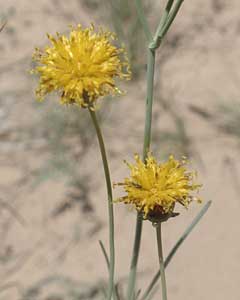 |
|
http://commons.wikimedia.org/wiki/User:JerryFriedman |
 |
| http://commons.wikimedia.org/wiki/User:JerryFriedman |
Translate this page:
Summary
UPDATE: This plant, Thelesperma megapotamicum, was originally named Thelesperma megapotanicum in this database.
Physical Characteristics

 Thelesperma megapotamicum is a PERENNIAL growing to 0.5 m (1ft 8in).
Thelesperma megapotamicum is a PERENNIAL growing to 0.5 m (1ft 8in).
See above for USDA hardiness. It is hardy to UK zone 9. The species is hermaphrodite (has both male and female organs) and is pollinated by Insects.
Suitable for: light (sandy), medium (loamy) and heavy (clay) soils and prefers well-drained soil. Suitable pH: mildly acid, neutral and basic (mildly alkaline) soils. It cannot grow in the shade. It prefers dry or moist soil.
UK Hardiness Map
US Hardiness Map
Synonyms
Thelesperma megapotanicum
Plant Habitats
Edible Uses
Flower buds[183]. No more details are given. A tea is made from the fresh or dried leaves and flowering stems[257, 183]. When well made it is delicious, with just a hint of mint in its aftertaste[183].
References More on Edible Uses
Medicinal Uses
Plants For A Future can not take any responsibility for any adverse effects from the use of plants. Always seek advice from a professional before using a plant medicinally.
The plant has been used in the treatment of children with tuberculosis[257]. An infusion of the leaves and stems has been used as a 'nervous stimulant'[257]. An infusion of the leaves and stems has been used as a treatment for the teeth[257].
References More on Medicinal Uses
The Bookshop: Edible Plant Books
Our Latest books on Perennial Plants For Food Forests and Permaculture Gardens in paperback or digital formats.

Edible Tropical Plants
Food Forest Plants for Hotter Conditions: 250+ Plants For Tropical Food Forests & Permaculture Gardens.
More

Edible Temperate Plants
Plants for Your Food Forest: 500 Plants for Temperate Food Forests & Permaculture Gardens.
More

More Books
PFAF have eight books available in paperback and digital formats. Browse the shop for more information.
Shop Now
Other Uses
A yellow dye is obtained from the flowers[61]. Reddish-brown according to another report[257]. A brown dye is obtained from the leaves and stems[61]. An orange-yellow dye can be obtained from the boiled roots[257].
Special Uses
References More on Other Uses
Cultivation details
Succeeds in any moderately fertile well-drained soil in full sun[200]. This species is not very hardy outdoors in Britain, usually requiring cold greenhouse treatment[1]. According to one report this species might be no more than a synonym for T. gracile[183].
References Carbon Farming Information and Carbon Sequestration Information
Temperature Converter
Type a value in the Celsius field to convert the value to Fahrenheit:
Fahrenheit:
The PFAF Bookshop
Plants For A Future have a number of books available in paperback and digital form. Book titles include Edible Plants, Edible Perennials, Edible Trees,Edible Shrubs, Woodland Gardening, and Temperate Food Forest Plants. Our new book is Food Forest Plants For Hotter Conditions (Tropical and Sub-Tropical).
Shop Now
Plant Propagation
Seed - sow spring in situ, only just covering the seed. In dry weather the seed should be watered in. Division might be possible.
Other Names
If available other names are mentioned here
Native Range
NORTHERN AMERICA: United States (Kansas, Nebraska, Oklahoma, South Dakota, Colorado, Wyoming, Arkansas, New Mexico, Texas, Arizona, Utah, Mexico (Chihuahua, Coahuila de Zaragoza) SOUTHERN AMERICA: Argentina, Uruguay
Weed Potential
Right plant wrong place. We are currently updating this section.
Please note that a plant may be invasive in one area but may not in your area so it's worth checking.
Conservation Status
IUCN Red List of Threatened Plants Status :

Growth: S = slow M = medium F = fast. Soil: L = light (sandy) M = medium H = heavy (clay). pH: A = acid N = neutral B = basic (alkaline). Shade: F = full shade S = semi-shade N = no shade. Moisture: D = dry M = Moist We = wet Wa = water.
Now available:
Food Forest Plants for Mediterranean Conditions
350+ Perennial Plants For Mediterranean and Drier Food Forests and Permaculture Gardens.
[Paperback and eBook]
This is the third in Plants For A Future's series of plant guides for food forests tailored to
specific climate zones. Following volumes on temperate and tropical ecosystems, this book focuses
on species suited to Mediterranean conditions—regions with hot, dry summers and cool, wet winters,
often facing the added challenge of climate change.
Read More
Expert comment
Author
(Spreng.)Kuntze.
Botanical References
1274
Links / References
For a list of references used on this page please go here
Readers comment
| Add a comment |
|
If you have important information about this plant that may help other users please add a comment or link below. Only comments or links that are felt to be directly relevant to a plant will be included. If you think a comment/link or information contained on this page is inaccurate or misleading we would welcome your feedback at [email protected]. If you have questions about a plant please use the Forum on this website as we do not have the resources to answer questions ourselves.
* Please note: the comments by website users are not necessarily those held by PFAF and may give misleading or inaccurate information.
To leave a comment please Register or login here All comments need to be approved so will not appear immediately.
|
Subject : Thelesperma megapotamicum
|
|
|
|